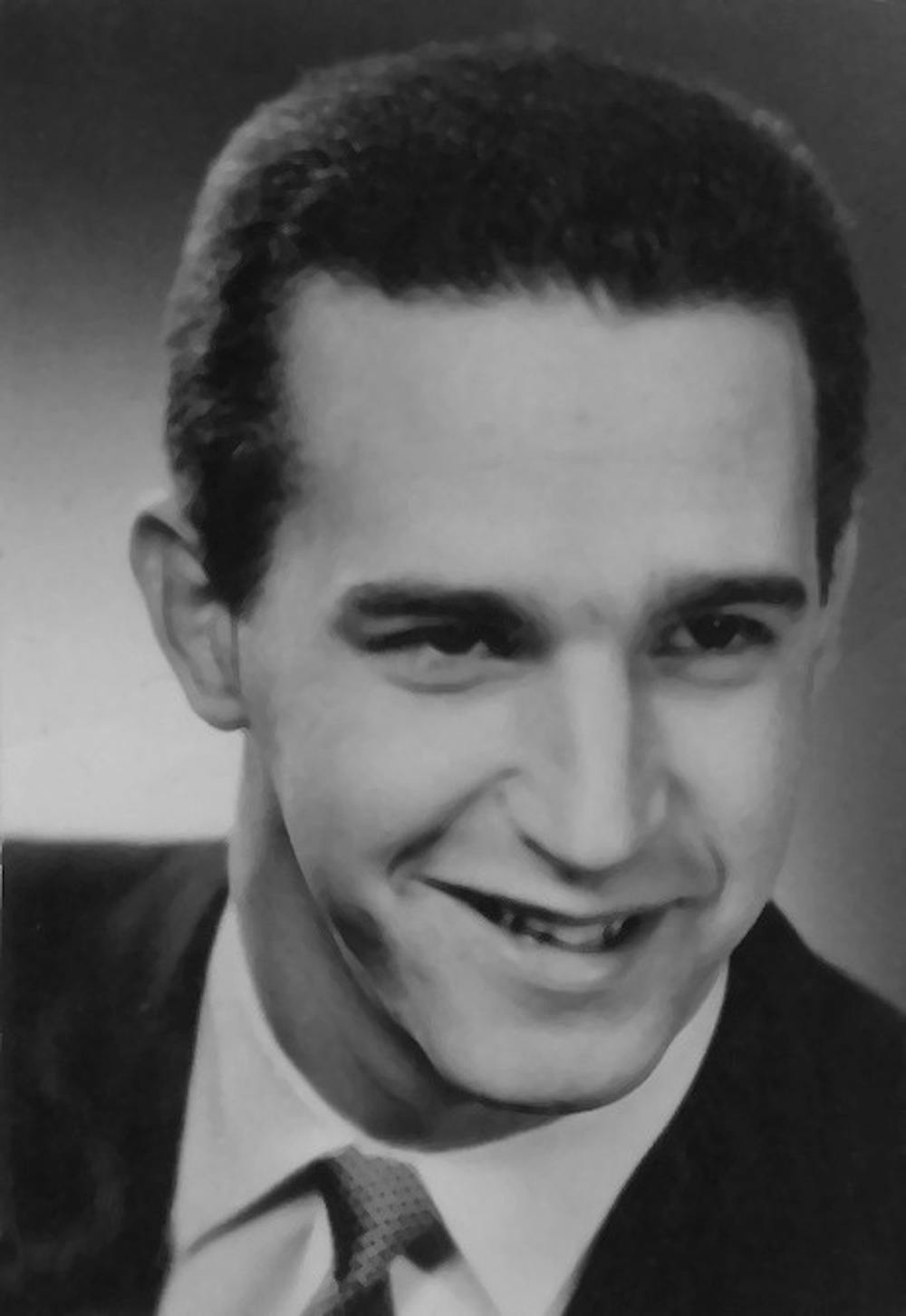Was it amnesia? Maybe a government cover-up? Or a case of foul play?
Theories on the whereabouts of former Miami University student Ronald Tammen Jr. continue to abound as April 19 marks the 70th anniversary of his disappearance.
Miami alumna Jennifer Wenger, ’80, is currently writing a book about her investigation into Tammen’s disappearance.
“I’d heard about Tammen’s disappearance when I was a student at Miami, and the scant details were always told in a super-secret, hush-hush way, usually around Halloween,” Wenger wrote in her blog A Good Man Is Hard to Find – My Search for Ronald H. Tammen, Jr. “I remember the vibe being a little eerie.”
Tammen, from Maple Heights, a suburb of Cleveland, was a Delta Tau Delta fraternity member, wrestler and string bass player in a college jazz band, the Campus Owls. He was also a resident assistant (RA) on the second floor of a men’s dormitory, Fisher Hall, which is now the location of Miami’s Marcum Hotel and Conference Center. He was well liked, dependable and had a wide range of responsibilities.

Tammen was strong bass player in a college jazz band, the Campus Owls.
On Sunday, April 19, 1953, Tammen discovered a fish in his bed, one prank among a series of practical jokes between him and a friend who also lived in Fisher Hall. The residence hall manager reported briefly interacting with Tammen between 8 and 8:30 p.m. while he was getting new bed sheets, during which Tammen mentioned he would be going straight to bed.
However, Wenger’s blog also featured another account by a member of the Delta Tau Delta fraternity who recalled attending a fraternity event at 9 or 10 p.m. Ron was at the event, and they walked back toward Fisher Hall together around 10:30 p.m. but parted ways before it could be determined if Tammen made it inside.
Charles Findlay, Tammen’s roommate, also returned to their dormitory around 10:30 p.m. after being gone since Friday, April 17. He reported that the door to their room was already open when he arrived, which was normal considering Tammen’s status as an RA.
The radio and lights were on, Tammen’s bed had been made with fresh sheets, and there was a psychology textbook on his desk, even though he was a business major. His wallet and car keys were also in the room. Tammen’s car was sitting in the parking lot, locked with his string bass inside. Findlay assumed Tammen would soon return and went to bed with the room in the state he found it.
It was a cold night with snow flurries in the air, and Tammen — along with his wristwatch, the clothes he was wearing and a light jacket — was unaccounted for.
Findlay reported Tammen missing to school authorities when he had still not returned on Monday. When this reached Carl Knox, the dean of men, Knox told Findlay on Tuesday that it was normal for stressed students to take time off and that Tammen might return in a day or two, according to an article in The Journal News by local journalist Joe Cella. It was not until Thursday that the university and local police took action.
Enjoy what you're reading?
Signup for our newsletter
Resulting searches produced nothing. Tammen’s local bank account remained untouched. Police quickly discounted foul play because Tammen’s background as a wrestler and his athletic ability, coupled with the general orderliness of the dorm, did not point to signs of a struggle. Believing Tammen had suffered from amnesia, police theorized he had simply wandered off.

Tammen was a wrestler at Miami.
In June 1953, a woman in nearby Seven Mile, Ohio, reported a man matching Tammen’s description had knocked on her door on the same night of Tammen’s disappearance to ask for directions, as reported by The Miami Student in 1953. In August 1953, a sighting in New York was reported to Knox by a university housing official. There have been no other reported sightings of Tammen since 1953.
However, Dr. Garrett Boone, a doctor in Hamilton, told police that in November 1952, Tammen had visited his office to find out his blood type, according to a 1973 Journal-News article by Cella. Although Boone stressed to authorities it was extremely uncommon for someone to only request for getting their blood type tested, police reportedly brushed this off and didn’t pursue the lead any further.
Fisher Hall was torn down in 1978. Officials searched for human remains, but none were found.
As for current Miami students, few are aware of the case.
But Marina Carey and Lyndsey Carter are exceptions. Both first learned about Tammen’s disappearance through Fred Reeder Jr., a journalism professor at Miami. Reeder was working with Wenger to pitch a documentary to Netflix about Tammen’s disappearance.
“I wish more people knew about it,” Carey said.
Carter agreed with Carey and said if more people were aware of the case, there would be more urgency to uncover what happened.
“If there’s more exposure to a case … there’s more pressure for law enforcement to continue to investigate it,” Carter said. “The university just didn’t take it as seriously as it should have been taken.”
Even though the case has been unsolved for 70 years, Carey said she likes to imagine that Tammen had a good life.

Tammen on his prom night posing with his siblings.
“I would like to think that he lived to an older age and … got to live the life that he wanted to live,” Carey said, “regardless of what that looked like.”
Miami alumna investigates ongoing mystery of missing student
In 1978, Miami University student Jennifer Wenger stumbled upon the mysterious tale of the disappearance of Miami sophomore Ronald Tammen Jr. just 25 years prior. Her tour of Fisher Hall – the residence hall of Tammen and the last place he was seen before his disappearance – would launch Wenger into an ever-growing fascination with his disappearance.
“Our student guide was totally convinced that the building was full of ghosts and they had somehow spirited Tammen away,” Wenger reflects in her blog A Good Man Is Hard to Find – My Search for Ronald H. Tammen, Jr. “Personally, I pictured Tammen on a remote island somewhere, living simply yet supremely, chuckling at the stunt he was somehow able to pull off, for whatever reason.”
But decades passed, and it wasn’t until 2010 that Wenger decided to research Tammen’s disappearance. According to her blog, she “was going through a rough patch … I needed a project. More specifically, I wanted to write a book. … That’s when Ron Tammen came to mind.”
Determined to solve Tammen’s disappearance, Wenger left her job in 2014. Working on the case full time, her research has brought forth more clues and previously unknown and conflicting information regarding Tammen and his disappearance.
Wenger believes Tammen was still alive in 2002. Following Tammen’s disappearance, his mother sent a set of fingerprints he had made for a project in elementary school to the FBI. When Wenger requested Tammen’s fingerprints from the FBI, they had been expunged. Through further investigation, Wenger discovered that the fingerprints could only have been expunged from a court order or from Tammen himself.
“The only person that can ask that those prints be expunged is the subject of that record,” Wenger said. “That’s Ron Tammen.”
Wenger also believes Tammen’s disappearance was connected to the CIA. She explained that the psychology book open on Tammen’s desk was for a psychology class he dropped before his disappearance.
“His psychology professor was St. Clair Switzer,” Wenger wrote. “… I have documentation to indicate that he was probably affiliated with the CIA the semester that Ron Tammen disappeared. And more specifically, St. Clair was a hypnosis expert.”
Before Switzer had earned his expertise in hypnosis, he was a pharmacist. He also held a high position in the Air Force Reserve and worked at the Pentagon following World War II.
Furthermore, Wenger discovered there were individuals outside Fisher Hall possibly recruiting for hypnosis studies through the psychology department.
On April 19, Wenger released new details regarding the possible withholding of information by those with interest in Tammen’s disappearance, as well as a check that was written by someone named Dorothy Craig to Tammen shortly before his disappearance.
According to Wenger, Craig worked as a stenographer at Champion Paper and Fibre Company in Hamilton. Craig’s boss was Lt. Col. Reuben Buck Robertson Jr., who was president of the company and worked with a plethora of government officials in various departments, including the Department of Defense before and during his presidency.
Robertson was also the nephew of Mary Moore Dabney Thomson, who was largely known for her role as president of the Western College for Women. Additionally, Robertson was on the committee of Miami’s Board of Trustees that elected John D. Millett in March 1953 as the university’s next president.
Ultimately, Wenger surmised Tammen’s possible connection with CIA-related activities at Miami, potentially funded by Roberston.
The check written by Craig, Wenger concluded, was payment to Tammen regarding his involvement with these hypnosis studies.
“You look at this stuff 13 years ago and it means nothing,” Wenger said. “And then you start learning things, putting things together … that could possibly pertain to this situation and it’s pretty exciting.”




